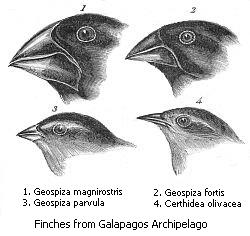Evolutionary biologists are often concerned with genetic variation, a term which in modern times has come to refer to differences in DNA sequences among individuals. However, quantifying and understanding genetic variation has been a central aim of those interested in understanding the varied life on earth since long before the sequencing of the first full genome, and even before the discovery of DNA as the molecule responsible for heredity.
While today's definition of genetic variation relies on contemporary molecular genetics, the idea of heritable variation was of central importance to those interested in the substance and development of life even before the writings of Charles Darwin. The concept of heritable variation—the presence of innate differences between life forms that are passed from parents to offspring, especially within categories such as species—does not rely on modern ideas of genetics, which were unavailable to 18th- and 19th-century minds.
Pre-Darwinian concepts of heritable variation
In the mid-1700s, Pierre Louis Maupertuis, a French scholar now known primarily for his work in mathematics and physics, posited that while species have a true, original form, accidents during the development of nascent offspring could introduce variations that could accumulate over time. [17] In his 1750 Essaie de Cosmologie, he proposed that the species we see today are only a small fraction of the many variations produced by "a blind destiny", and that many of these variations did not "conform" to their needs, thus did not survive. [18] In fact, some historians even suggest that his ideas anticipated the laws of inheritance further developed by Gregor Mendel. [19]
Simultaneously, French philosopher Denis Diderot proposed a different framework for the generation of heritable variation. Diderot borrowed Maupertuis' idea that variation could be introduced during reproduction and the subsequent growth of offspring, [20] and thought that production of a "normal" organism was no more probable than production of a "monstrous" one. [21] However, Diderot also believed that matter itself had lifelike properties and could self-assemble into structures with the potential for life. [20] Diderot's ideas on biological transformation, introduced in his 1749 work Letter on the Blind, were thus focused on variability of spontaneously generated forms, not variability within existing species. [22]
Both Maupertuis and Diderot built on the ideas of Roman poet and philosopher Lucretius, who wrote in De rerum natura that all the universe was created by random chance, and only the beings that were not self-contradictory survived. [23] Maupertuis' work is distinguished from the work of both Lucretius and Diderot in his use of the concept of conformity in explaining differential survival of beings, a new idea among those who believed that life changed over time. [23]
Like Diderot, two other influential minds of the 18th century—Erasmus Darwin and Jean-Baptiste Lamarck—believed that only very simple organisms could be generated by spontaneous generation, so another mechanism was necessary to generate the great variability of complex life observed on earth. [17] Erasmus Darwin proposed that changes acquired during an animal's life could be passed to its offspring, and that these changes seemed to be produced by the animal's endeavors to meet its basic needs. [24] Similarly, Lamarck's theory of the variability among living things was rooted in patterns of use and disuse, which he believed led to heritable physiological changes. [17] Both Erasmus Darwin and Lamarck believed that variation, whether it arose during development or during the animal's life, was heritable, a key step in theories of change over time extending from individuals to populations.
In the subsequent century, William Herschel's telescopic observations of diverse nebulae across the night sky suggested to him that different nebulae could each be in different stages in the process of condensation. This idea, which came to be known as the nebular hypothesis, suggested that natural processes could both create order out of matter and introduce variation, and that these processes could be observed over time. [17] While it may seem to the modern reader that astronomical theories are irrelevant to theories of organic variation, these ideas became significantly conflated with ideas of biological transformation—what we now know as evolution—in the mid-19th century, laying important groundwork for the work of subsequent thinkers such as Charles Darwin. [25]
Darwin's concept of heritable variation
Charles Darwin's ideas of heritable variation were shaped by both his own scientific work and the ideas of his contemporaries and predecessors. [26] Darwin ascribed heritable variation to many factors, but particularly emphasized environmental forces acting on the body. His theory of inheritance was rooted in the (now disproven) idea of gemmules - small, hypothetical particles, which capture the essence of an organism and travel from all over the body to the reproductive organs, from which they are passed to offspring. [27] Darwin believed that the causal relationship between the environment and the body was so complex that the variation this relationship produced was inherently unpredictable. [28] However, like Lamarck, he acknowledged that variability could also be introduced by patterns of use and disuse of organs. [29] Darwin was fascinated by variation in both natural and domesticated populations, and his realization that individuals in a population exhibited seemingly purposeless variation was largely driven by his experiences working with animal breeders. [30] Darwin believed that species changed gradually, through the accumulation of small, continuous variations, a concept that would remain hotly contested into the 20th century. [31]








